
Wireless data transmission in the licence-free ISM frequency bands below 1 GHz is very popular thanks to its low power consumption, low costs and comparably simple implementation.
The strong rise in its deployment in established applications, such as in remote controls where it is used as a substitute for infrared technology, is now being flanked by many new applications where it is enabling new levels of ergonomics and new functionality.
As the first product in the new SmartLEWIS MCU family, Infineon’s PMA 7110 is targeted at implementation in a multitude of wireless transmission applications. The highly integrated circuit monolithically combines an 8051 microcontroller, an HF transmitter and other peripheral blocks on a single semiconductor chip. In particular, the analog-to-digital converter for connection of analog sensors and a 125 kHz LF receiver are noteworthy.
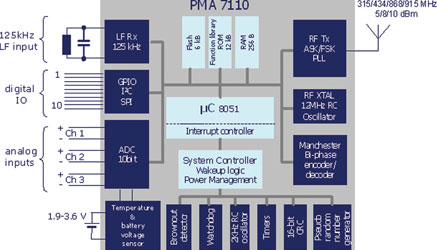
The analog-to-digital converter is characterised by an additional configuration area for amplification of the three symmetrical inputs. The LF receiver is suitable for contactless triggering of transmission processes and for contactless configuration (eg, personalisation or charging with credit). An extensive library of SW functions is integrated into the ROM by default, thereby saving valuable Flash memory. Typical applications can be implemented with comparatively little programming effort.
The strengths of the PMA 7110 can best be demonstrated in the application segments of conventional remote controls for control of an appliance or a system via an HF wireless link, and wireless sensors, in which diverse test variables are autonomously monitored and with which measured values are sent to a receiver in the event of particular states or events. In addition, identification applications (eg, smart tagging) can also be realised.
PMA 7110 as a wireless remote control
Wireless remote controls in the licence free sub-1 GHz frequency ranges are finding ever greater use in a wide number of applications. These applications can be implemented with the PMA 7710 as a simple single-chip solution, and demanding functions are possible thanks to the extensive integrated peripheral blocks and the free programmability.
Remote keyless entry (RKE) applications have been standard in the automotive sector for many years. Such applications can be implemented with the automotive qualified derivative PMA 5110. The PMA family enables application security by generating continuously changing key codes ('rolling codes'), with EEPROM emulation allowing continuous storage of information in active operation (for each key action) in a reserved part of the nonvolatile Flash memory. The encryption of the transmitted information is realised using the licence-free AES algorithm, which is included as a basic feature in the software library in the chip's ROM.
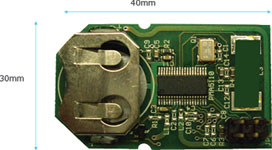
A pronounced growth in the number of applications for wireless remote controls can be seen in the consumer sector. The replacement of infrared remote controls in the entertainment and home electronics market has a key role to play in this growth. Apart from multiroom remote controls (eg, set-top boxes in neighbouring rooms), wireless remote controls – also acting as conventional infrared replacements – provide considerable ease of use because the remote controls no longer need to be directed toward the receiver.
The 10 free programmable digital inputs/outputs (GPIOs) of the PMA 7110 can be directly linked with up to 30 buttons (and even up to 55 buttons with additional diodes). Eight of the 10 lines can also be configured for wakeup signals, in which case the remote control, after sending the signal, immediately switches to standby mode with very low power consumption; the remote control remains inactive until a button is pressed again.
Depending on the design of the antenna used, the power consumption can be lower than that of infrared remote controls operating at the same distance, even during transmission. This means that markedly smaller batteries can be used, which, on the one hand, enables new design possibilities for remote control housings and, on the other hand, extends battery lifetime.
The PMA 7110 as a contactless sensor
Contactless sensors can be very flexibly arranged, thus providing greater ease of use and simpler installation on the one hand, while enabling even unusual measurements to be performed on the other hand – for example, operation on moving objects such as rotating machine parts. The low power consumption of the PMA 7110 is an important feature in this case because the battery capacity varies according to the specified target lifetime of the application, which in turn is important for the dimensions, weight and finally for the cost of the whole sensor module.
While sensors with a digital interface (eg, SPI) can be connected to the GPIOs of the PMA 7110, the chip also allows a variety of inexpensive analog sensors to be operated in the three channels of the analog-to-digital converter (ADC). The flexible configuration of the symmetric inputs also enables high levels of input amplification so that additional preamplifiers can be dispensed with in many cases.
A number of strategies could be employed to minimise the power consumption of the application. For example, a measured value needs only be transmitted over the air interface if particular threshold values are exceeded. Extremely long battery lifetimes can be realised if the contactless sensor is only 'woken up' by wireless activation as required by means of the LF receiver. Along with the two timers in the 8051 microcontroller core, there are two further timers that can be used for complex timing scenarios.
Peripheral block LF receiver
The LF receiver is suitable for receiving amplitude modulated 125 kHz signals that are magnetically induced in a receiver coil. Since the receiver is only activated by means of the induced energy, it consumes practically no power in standby mode. In the most straightforward case, the LF receiver can be used for contactless triggering of a transmission procedure. To do so, the user employs a 125 kHz transmission signal, a so-called trigger, activated in the vicinity of the HF transmitter. The HF transmitter responds with measured sensor data or an identification code.
In a similar manner, data can also be sent to the HF transmitter using 125 kHz amplitude modulation. This function could be used, for example, for contactless calibration of a sensor transmission unit or for one-time storage of identification codes in the HF transmission device – for example, for customer data at a point of sale.
SW function library and framework
Programming of the 8051-compatible microcontroller in C and Assembler is itself uncomplicated. Nonetheless, the SW function library stored in ROM in the PMA family allows efficient access to all on-chip peripheral functions without a programmer having to know in detail the bits and bytes of the chip's system architecture. This means that the programmer can very quickly produce complex applications using relatively few, powerful function calls. Figure 3 shows an example of a C main routine demonstrating how easily an RF (radio frequency) thermometer can be programmed. The SW library functions are indicated in bold typeface.
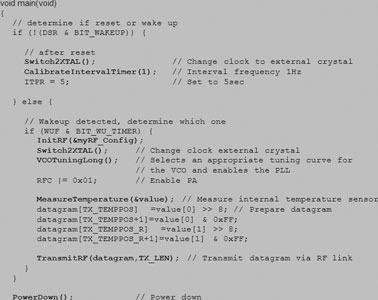
Another key advantage of this concept is that the size of the application-specific code can be kept very small since most of the code is already present in the pre-programmed function library in ROM. Subsequently, the 6 KB Flash memory allows considerably more extensive applications to be implemented than in comparable µC architectures in which the entire program code has to be stored in valuable Flash memory. Another benefit deriving from this architecture is the reduction in Flash programming times.
Development tools
Infineon provides extensive development tools for products in the PMA 71xx and 51xx families.
The PMA 71xx/51xx USB RF Kit contains everything needed for initial evaluation and creation of uncomplicated applications. Its main component is a USB stick that supports all the major functions of the PMA 7110 chip, and also features a rechargeable lithium-ion battery to enable mobile operation of a newly created application.
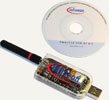
Product family, fundamental data and chip housing
The PMA derivatives from the 71xx series are intended for use in industrial and consumer applications and are designed for an operating temperature range from -40°C to +85°C. The 51xx series is Q100 automotive-qualified and can be used in an operating temperature range from -40°C to +125°C. All derivatives in the PMA product family are pin-compatible in a standard P-TSSOP-38 housing. Most of the printed circuit board layout can be left unchanged for product derivatives. The functional differences in the PMA product family refer to the availability of LF receivers and analog-to-digital converters, as shown in Table 1:
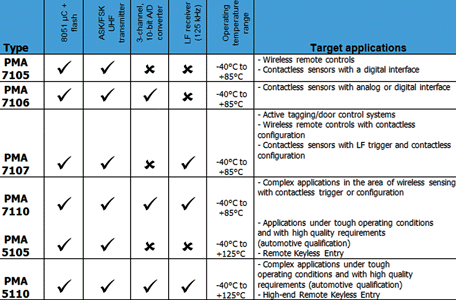
For more information contact EBV Electrolink, +27 (0)21 402 1940, [email protected], www.ebv.com, Electrocomp, +27 (0)11 458 9000, [email protected], www.electrocomp.co.za
| Tel: | +27 11 236 1900 |
| Email: | [email protected] |
| www: | www.ebv.com |
| Articles: | More information and articles about EBV Electrolink |
| Tel: | +27 11 458 9000 |
| Email: | [email protected] |
| www: | www.electrocomp.co.za |
| Articles: | More information and articles about Electrocomp |

© Technews Publishing (Pty) Ltd | All Rights Reserved